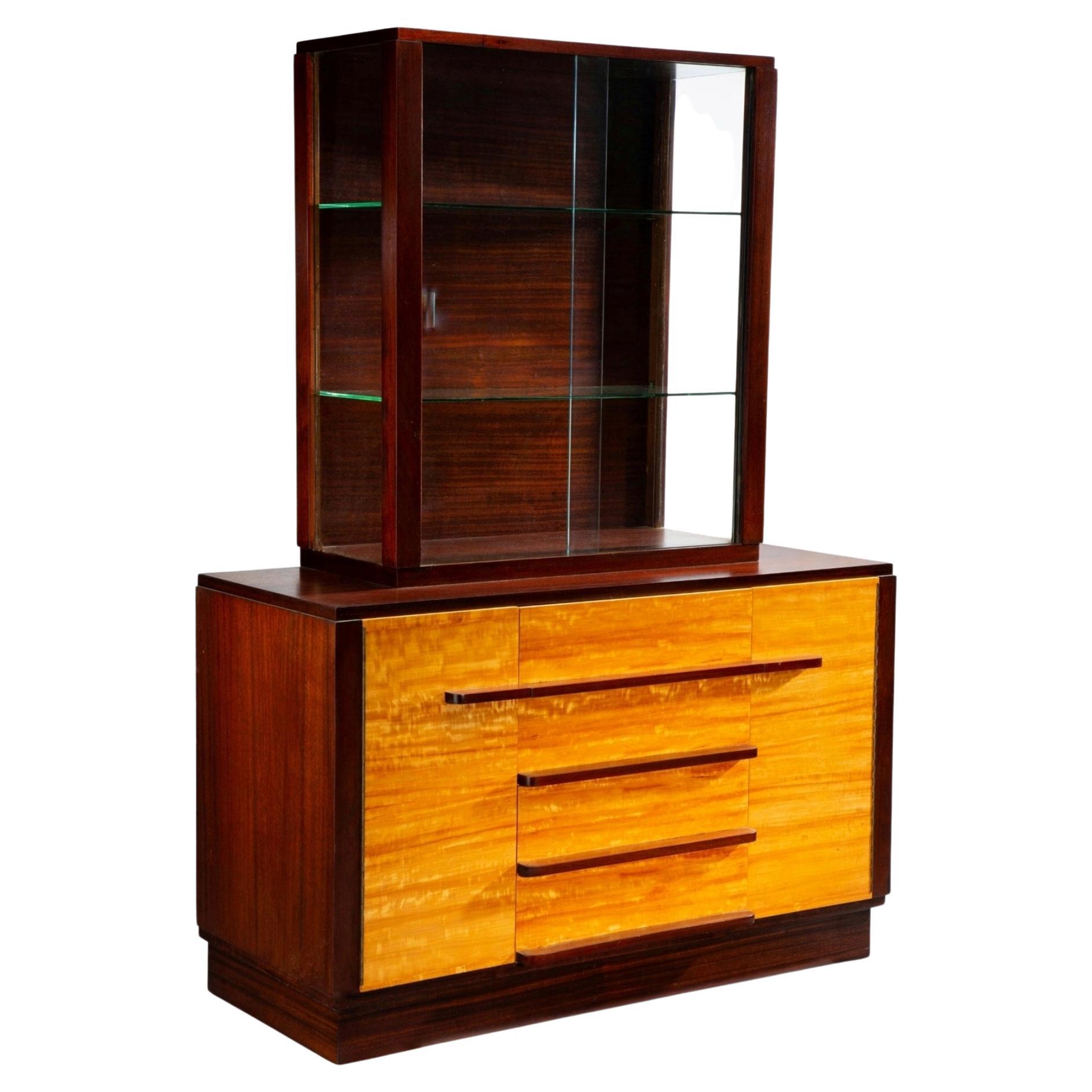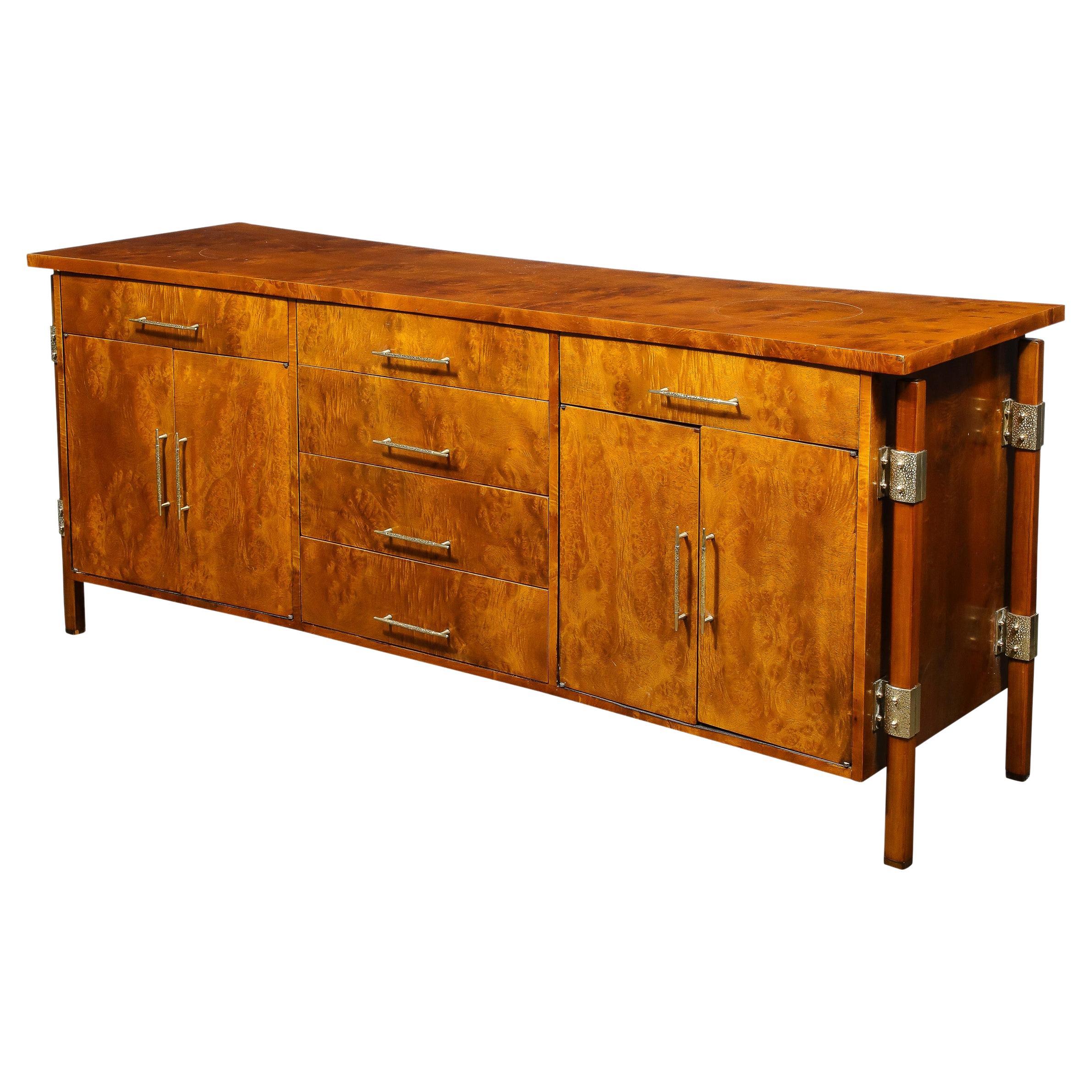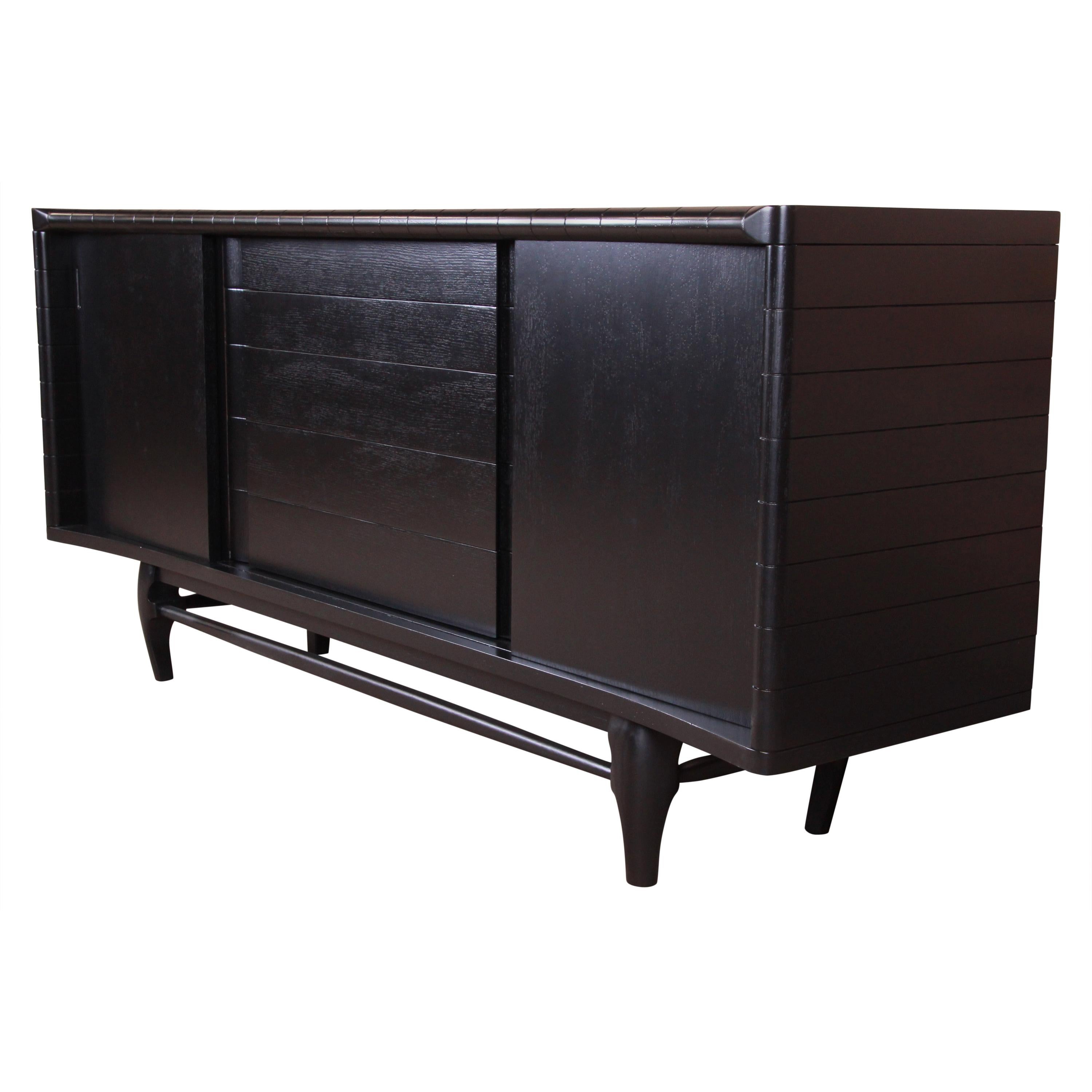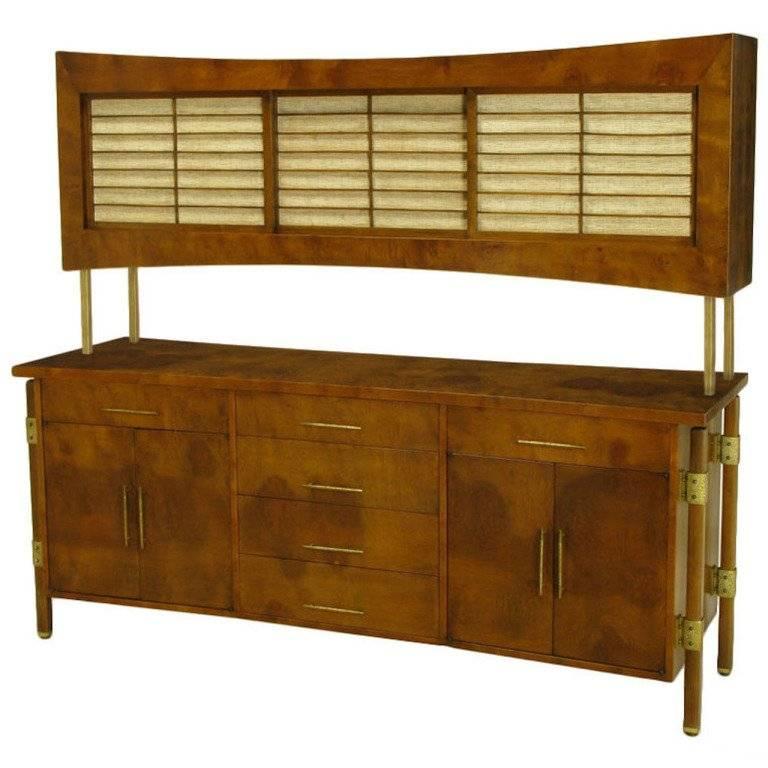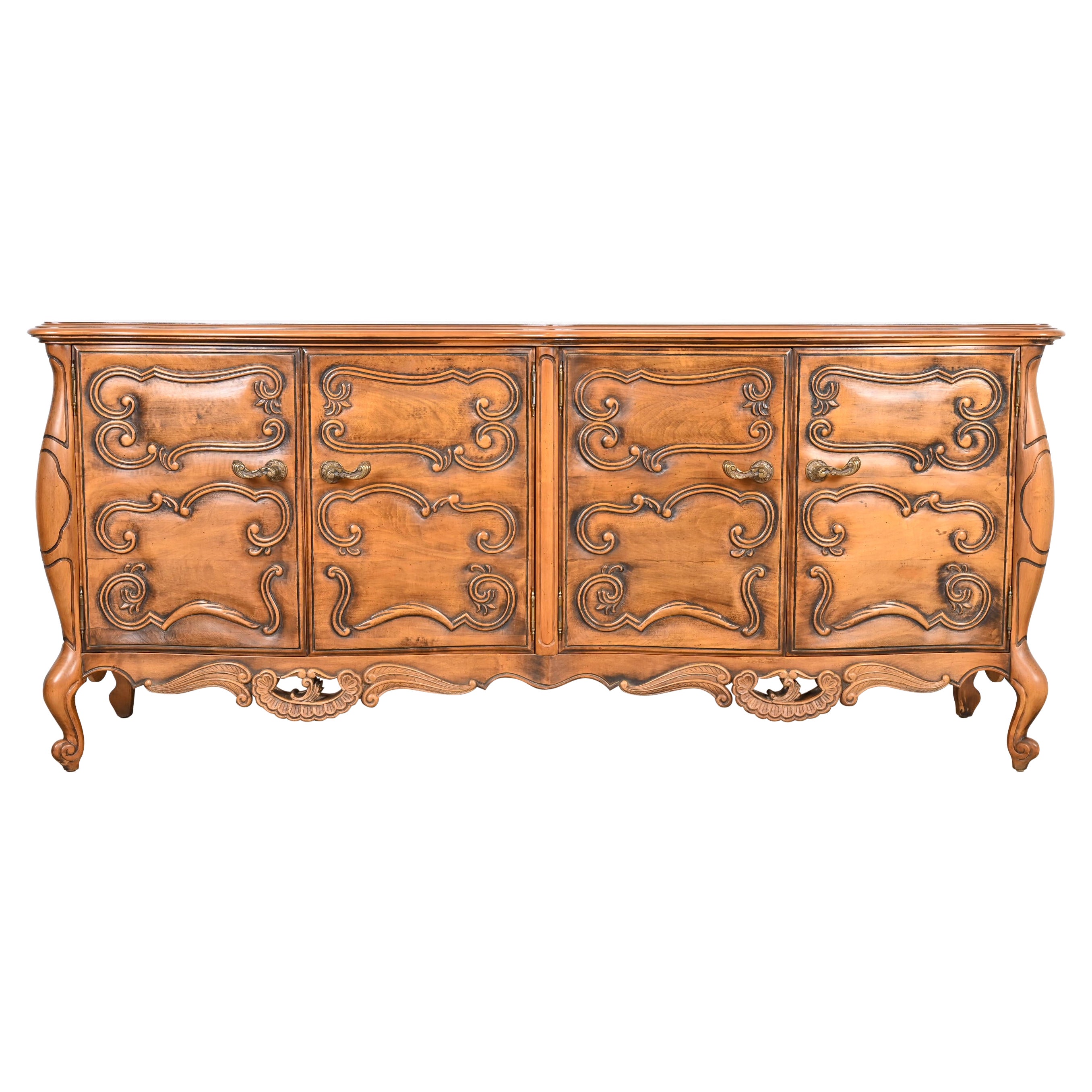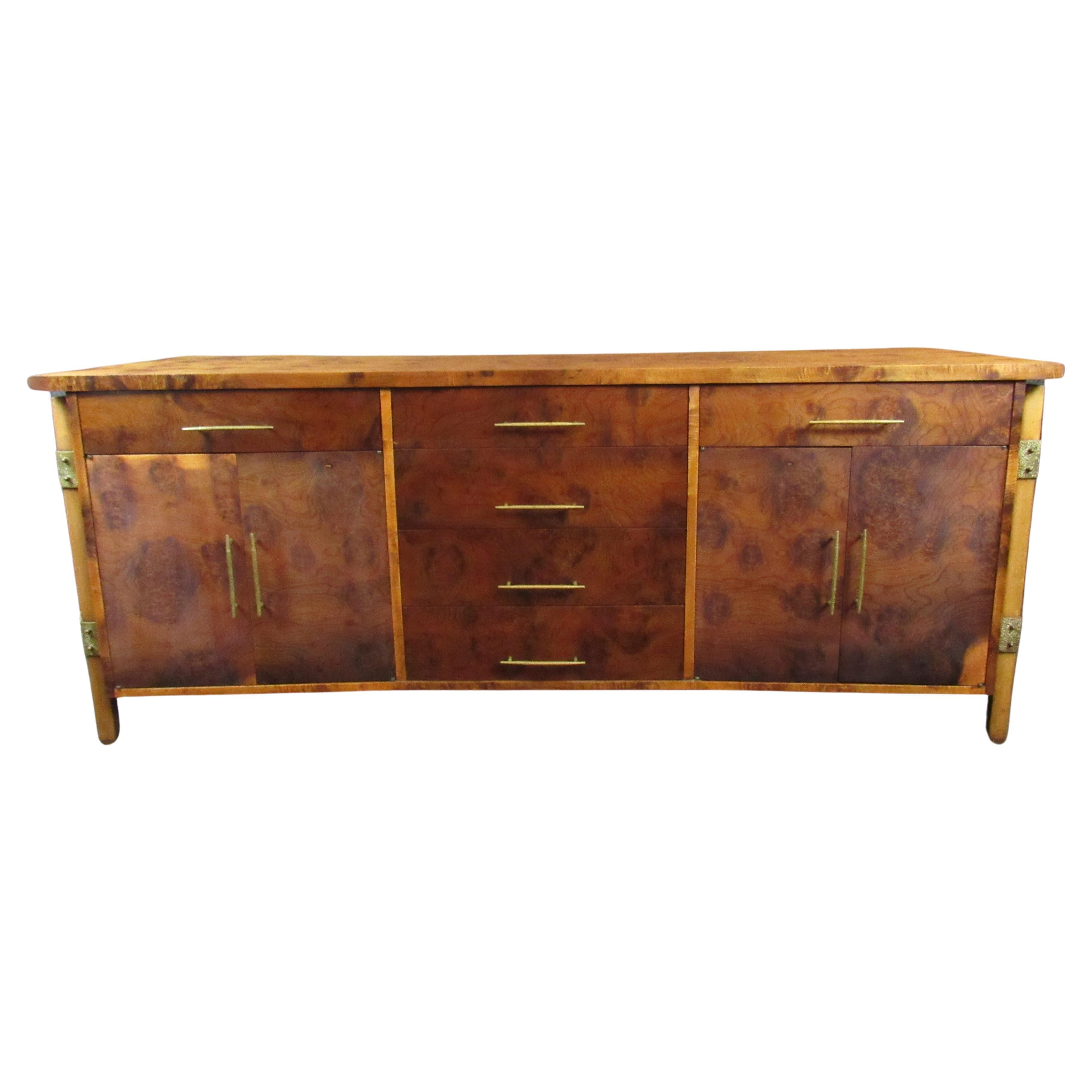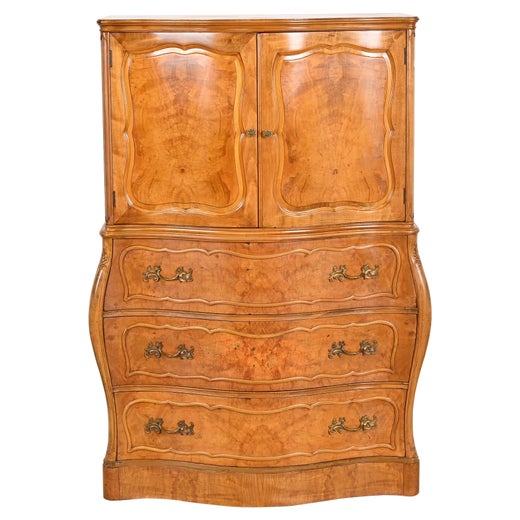Art Deco Wolfgang Hoffmann Romweber World's Fair Century of Progress Sideboard
About the Item
- Creator:Wolfgang Hoffmann (Designer),Romweber Furniture Co. (Cabinetmaker)
- Dimensions:Height: 30 in (76.2 cm)Width: 49 in (124.46 cm)Depth: 20 in (50.8 cm)
- Style:Art Deco (Of the Period)
- Materials and Techniques:
- Place of Origin:
- Period:
- Date of Manufacture:circa 1933-1936
- Condition:Wear consistent with age and use. Overall excellent condition. Presents splendidly w/nicely aged patina. Highly desirable original unrestored vintage condition. May have very minor age appropriate wear. Overall a superb museum quality example. Delivered cleaned, waxed, ready for use!
- Seller Location:Forney, TX
- Reference Number:1stDibs: LU5977234499412
Romweber Furniture Co.
Some vintage Romweber Furniture Company designs may strike the young as passé. But for fans of a certain age, the American brand never went out of style.
The Romweber story began in the late 1800s, with the launch of American Furniture Company, which made bedroom furniture, Batesville Cabinet Company, a dining-room-set manufacturer, and Batesville Coffin Company. The three companies eventually merged to become a large and reputable manufacturer of case goods, furniture and more. Not unlike many American companies, production at Romweber suffered during the Great Depression. The brand managed to stay afloat by making a rather strange pivot — to selling five-pound fruitcake boxes. During the Second World War, Romweber pivoted again, this time to the production of ammunition boxes and pontoons for American troops and, naturally, furniture for officers’ quarters.
While Romweber furniture (spelled “RomWeber” in vintage advertisements), dating back to the early 20th century, had designers working in the French Rococo and Chippendale styles, the brand is best known for its mid-century modern pieces. In the postwar years, Romweber manufactured walnut case pieces and storage cabinets that featured decorative olive-ash and burl-wood inlays with brass hardware as well as solid oak credenzas and dining tables designed by the likes of Harold Schwartz. For collectors of sophisticated 1950s furniture, the company’s sturdy Viking Oak line is particularly popular.
“It’s not uncommon for customers to say, ‘My parents had this Romweber Viking set,’” says Adam Cramer of collectors who visit Liberty & 33rd, the gallery he owns with his wife in South Bend, Indiana, about three hours north of Romweber’s birthplace in small-town Batesville. “It’s solid oak,” Cramer tells 1stDibs of the line of tables, chairs, desks and more.
Solid oak is the product of slow-growing deciduous trees. Solid oak furniture is durable, desirable and an investment that is usually associated with a hefty price. In solid oak furnishings, such as those that make up the covetable Romweber Viking Oak line, which launched in 1935, there aren’t any scraps of other components in the construction. Inspired by Scandinavian folk design, Romweber’s Viking Oak is said to have enjoyed one of the longest runs for a commercial furniture line in history. The collection went out of production in the late 1980s, and mid-century editions remain highly prized for their exceptional quality and hand-carved details.
Find vintage Romweber furniture on 1stDibs.
- ShippingRetrieving quote...Ships From: Forney, TX
- Return PolicyA return for this item may be initiated within 7 days of delivery.
- Art Deco Signed Wolfgang Hoffmann for Romweber World's Fair Display CabinetBy Wolfgang Hoffmann, Romweber Furniture Co.Located in Forney, TXA rare and important Art Deco period Century of Progress Display Cabinet designed by Wolfgang Hoffmann (Austrian, 1900-1969) for Romweber Company, Batesville, Indiana, United States of America. circa 1933-1936 Created for the 1933 Chicago World's Fair, one piece design, having a rectangular showcase top with glass panel sides and a pair of sliding glass doors, over solid wood chest fitted with four drawers affixed with horizontal pulls, flanked by cabinet doors, opening to shelved interior. Rosewood, mahogany, richly figured blonde - golden birch or primavera, and glass. Signed, original label to drawer interior, featuring 1933 World's Fair mark impressed. **Please note, at the time of writing this, a matching sideboard - buffet (shown in last photo) is currently available separately** Provenance / Acquisition: Property from the important and iconic collection of Mr. James I. Rafftesaeth Jr., Dallas, Texas Acquired from highly reputable auction house, Heritage Auctions, Dallas, Texas. 2022 Design Signature Auction catalog #8091 History: Wolfgang Hoffmann was born in Vienna, Austria in 1900. He is the son of famous architect, pedagogue and Wiener Werkstatte cofounder, Joseph Hoffmann (1870-1956). Early on, following his father’s s interests, he was trained in the decorative arts and design. Wolfgang Hoffmann once reminisced, “I spent eight years at the Realschule, then three years went to a special architectural school, where I perfected my technical knowledge of architecture and general construction. From this school, I was graduated to the Kunstgewerbeschule [Studying under Oskar Strnad and Josef Frank in Vienna]. After finishing this school, I had one and a half years of practical in a well known architect’s office. Thereafter I worked in my Father’s office for two years”. Hoffmann met his future wife, Polish immigrant Pola (1902-1984) when they were both studying at the Kunstgewerbeschule. Joseph Urban (1872-1933) was needing an assistant for his architectural business in New York and contacted his friend and colleague, Joseph Hoffmann in Vienna. Hoffmann recommended his son Wolfgang. Urban hired him and sent a first class passage ticket to Vienna for Wolfgang to travel to New York. Wolfgang married Pola and traded his ticket for two tickets to America in steerage, arriving in New York City in December of 1925. Leaving the Urban office after nine months, Wolfgang and Pola formed an independent design practice with offices on Madison Avenue in Manhattan with the purpose of creating contemporary interiors and industrial designs. Early work included theaters, stores, and apartments mostly in New York City. During the late 1920’s and early 1930’s the Hoffmanns designed custom furniture for private clients. Some of these examples were shown in the February 1929 issue of House and Garden. Curiously, the examples’ design was attributed to Urban and the production to Pola Hoffmann, Inc. Established in the fall of 1928, the American Designers’ Gallery was “devoted exclusively to showing objects and interiors for practical use… by fourteen American architects and designers”. Its members included the Hoffmans and Urban as well as ceramist Henry Varnum Poor (1888-1971), architect Raymond Hood (1881-1934), artist designer Winold Reiss (1886-1953), graphic designer Lucien Bernhard (1896-1981), decorator Donald Deskey (1894-1989), and architect Ely Jacques Kahn (1884-1972). The Hoffmanns’ work was included in the American Designers’ Gallery’s two showcase events, its 1928 and 1929 exhibitions. Their dining alcove at the 1929 event featured a bench with a dinette table and two chairs in American walnut designed by Wolfgang and a rug by Pola. Lucien Bernhard, fellow Austrian immigrant who settled in New York a year before the Hoffmanns, operated the gallery and decorating service Contempora with Munich resident Bruno Paul (1874-1968). The Hoffmanns, occasionally participating with Contempora, designed a number of outstanding interiors, including the constructivist living room of 1930 for Mrs. O.R. Sommerich at 40 East 66th street. In 1934, Donald Deskey commissioned Wolfgang to design birchwood furnishings for the eclectic apartment at 625 Park Avenue belonging to Helena Rubinstein. In 1931, Wolfgang exhibited his work at the Pennsylvania Art Museum and the Museum of Modern Art in New York City. The same year, with Kem Weber (1889-1963) he organized the second and final exhibition of AUDAC- “Modern Industrial and Decorative Arts”- at the Brooklyn Museum. At this event, the Hoffmanns showed the dining room previously included in the American Designer’s Gallery’s 1929 exhibition in the Chase Bank Building lobby at 145 West 57th Street in Manhattan. In 1932 Wolfgang was asked to assist Urban in developing the color scheme for the 1933-34 Chicago World’s Fair “A Century of Progress”. He was also commissioned to design the interior and furniture for the fair’s lumber industries house. There he executed its living and dining rooms furnished by Kroehler Manufacturing Company of Chicago; the boys’ room by Shower Brothers...Category
Early 20th Century American Art Deco Vitrines
MaterialsGlass, Mahogany, Rosewood
- Exceptional French Louis Majorelle Art Nouveau SideboardBy Louis MajorelleLocated in Forney, TXAn extraordinary French walnut cabinet by Louis Majorelle (1859–1926) exceptionally executed period Art Nouveau styling. Circa 1900. Majorelle know for often ornamented his pieces...Category
Early 20th Century Art Nouveau Credenzas
MaterialsWalnut
- 19th Century Italian Renaissance Revival SideboardLocated in Forney, TXA rare Continental Italian Renaissance Revival oak and leather sideboard with warm, rich patina. Born in the early 19th century, exquisitely hand-crafted and exceptionally execut...Category
Antique Early 19th Century European Renaissance Revival Sideboards
MaterialsLeather, Oak
- 19th Century Hepplewhite Style Bow Front SideboardLocated in Forney, TXAn elegant late 19th century mahogany sideboard, finished in Hepplewhite taste, with later distressed painted white finish. Finely hand-crafted of mahogany solid woods, bow front demilune shaped, having a single drawer crafted of high quality solid oak and garnished with keyhole shaped escutcheon, over central arch shaped skirt, flanked by two hinged door cabinets designed to look like a pair using faux drawer fronts adorned in original patinated brass Neoclassical urn decorated ring pull fittings...Category
Antique 19th Century Hepplewhite Sideboards
MaterialsOak, Paint, Mahogany
- Early 19th Century Country French Bordeaux SideboardLocated in Forney, TXSouthwestern France, circa 1820, Provincial Picardie influences, having a rectangular three board planked top, over a trio of frieze drawers, featuring central open shelf wine bottle...Category
Antique Early 19th Century French Country Sideboards
MaterialsFruitwood
- 19th Century French Renaissance Revival Henry II SideboardLocated in Forney, TXFrench Perfection!! A most impressive Renaissance Revival Henry II style well carved solid walnut sideboard server from the second half of the 19th century, finished in later chic distressed dusty blue painted finish with light airy hues of chalky gray. Born in France, circa 1870, this piece is wonderfully hand carved and crafted with wonderful attention to detail. It features a rectangular wooden top over an ornate frieze with foliate carvings and decorative ornamentation, large dovetailed drawer in the center, flanked by a pair of smaller drawers, all affixed with original patinated brass pulls, rising over the open shelf base with classical arched fluted columns, paneled back, above stepped molded skirt, resting on bun feet. It's a most impressive piece with the commanding presence 16th century Henri II furniture is known for, including handsome masculine lines and strong architectural form, combined with a relaxed shabby chic farmhouse refinement, beautifully aged warmth, and unfussy elegant sophistication. Dimensions: (approx) 36" high, 44" wide, 23" deep Versatile. Having the ideal smaller size and proportions for a variety of different uses, including as a dining room sideboard or breakfast...Category
Antique Late 19th Century French Renaissance Revival Sideboards
MaterialsBrass
- Mid-Century Brutalist Burled Walnut Sideboard by Harold Schwartz for RomweberBy Harold Schwartz, Romweber Furniture Co.Located in New York, NYThis stunning Mid-Century Modern sideboard was designed by the illustrious Harold Schwartz and realized by the Romweber Furniture Company in the United States, circa 1950. It feature...Category
Vintage 1950s American Mid-Century Modern Sideboards
MaterialsBrass
- Harold Schwartz for Romweber Ebonized Sideboard Credenza, Newly RefinishedBy Harold Schwartz, Romweber Furniture Co.Located in South Bend, INAn exceptional Mid-Century Modern ebonized mahogany sideboard credenza or bar cabinet By Harold Schwartz for Romweber USA, 1950s M...Category
Vintage 1950s American Mid-Century Modern Sideboards
MaterialsMahogany
- Rare Harold M. Schwartz for Romweber Burled Sideboard with Floating CabinetBy Romweber Furniture Co., Harold SchwartzLocated in Chicago, ILDesigned by Harold M. Schwartz for Romweber. Burled walnut side board with fiddle back highlights. Brutalist textured brass hardware, including brack...Category
Vintage 1950s American Mid-Century Modern Sideboards
MaterialsBrass
- Romweber French Rococo Louis XV Carved Walnut Sideboard or CredenzaBy Romweber Furniture Co.Located in South Bend, INA gorgeous French Rococo Louis XV style sideboard, credenza, or bar cabinet By Romweber USA, circa 1960s Carved walnut, with original brass hardware. Measures: 78.5"W x 2...Category
Vintage 1960s American Rococo Sideboards
MaterialsBrass
- Romweber Burl CredenzaBy Romweber Furniture Co.Located in Brooklyn, NYGorgeous mid-century credenza from the highly regarded Romweber Furniture of Batesville, Indiana. Stunning two-tone burl wood with brass accents is sure to be a statement piece in an...Category
Mid-20th Century Mid-Century Modern Credenzas
MaterialsBrass
- Romweber French Provincial Louis XV Burl Wood Sideboard or Bar Cabinet, 1920sBy Romweber Furniture Co.Located in South Bend, INAn exceptional French Provincial Louis XV style sideboard, credenza, or bar cabinet By Romweber USA, Circa 1920s Gorgeous book-matched exotic burled acacia wood, with carved cabri...Category
Vintage 1920s American Louis XV Sideboards
MaterialsBrass
